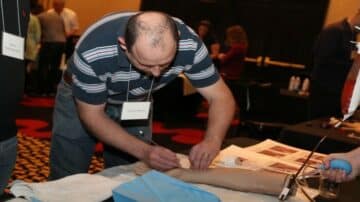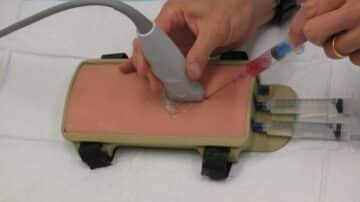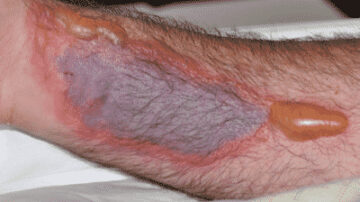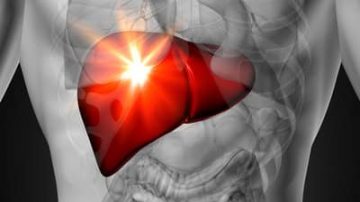In the United States, about 8 million catheters are inserted into arteries each year. From this group, a significant number are performed at teaching institutions by residents physicians and at other hospitals usually in the ICU, the OR and occasionally…
Read MoreIf a patient is unconscious, unable to swallow, or oral medications are slow to take effect, it can be difficult to administer medication. An intravenous (IV) injection or infusion is a commonly used solution in such cases. Through the IV…
Read MorePoint-of-care ultrasound (POCUS) is a revolutionary diagnostic method that helps enhance physical examination at the point of care, that is, the patient’s bedside. Clinicians can use this tool to quickly diagnose medical conditions and guide treatment or bedside procedures, including…
Read MoreWhile vasopressors are typically administered through a central venous catheter (CVC), peripheral intravenous (PIV) administration is becoming more common in clinical practice. The safety of this administration method is now well-established and is a good alternative to CVC placement for…
Read MoreFor procedures involving lumbar punctures , sonographically guided lumbar punctures (SGLPs) have a higher propensity of being chosen when dealing with obese patients. This is based on findings of a randomized controlled trial conducted in 2007. The main takeaway from…
Read MoreMore Articles – Arterial line, Cardiovascular diseases, Central line, Chest Tube, Emergency Procedures, Endotracheal Intubation, Events, FAST Exam, Intraosseous line, King Tube, Laryngeal Mask Airway, Lumbar Puncture, Mechanical Ventilation, Medical General, medical procedures, Needle Decompression, Paracentesis, Procedural Sedation, RUSH Exam, Thoracentesis, Ultrasound-Guided Peripheral IV
Physicians, physician associates (PAs), and nurse practitioners (NPs) need to be adept in a range of essential medical emergency procedures that they must perform in an inpatient settings. These bedside procedures are accomplished readily, but only if you have the…
Read MorePeripheral vasopressor infusions are generally safe at low-moderate doses and for short durations, but you must watch the patient carefully for extravasation that can cause serious tissue injury. Traditionally, central lines were placed for administration of vasopressor infusions at any rate. We…
Read MoreThis blog will offer some expert recommendations to help guide the safety of hospital procedures at different platelet and coagulation profiles. Unfortunately, there are no strong evidence-based guidelines for hospital procedures dedicated to the study of patients with decompensated cirrhosis.…
Read MoreMore Articles – Central line, Featured Procedure, medical procedures, Ultrasound-Guided Peripheral IV
Safety checklists have been adopted by numerous industries to prevent errors and save lives. Checklists have been used for decades by industries as diverse as the aviation industry, construction companies, and professional chefs to prevent mistakes. In medicine, checklists have…
Read MoreMore Articles – Arterial line, Central line, Chest Tube, Emergency Procedures, Endotracheal Intubation, FAST Exam, Glidescope Intubation, Hospital Procedures, King Tube, Lumbar Puncture, Medical General, medical procedures, Needle Decompression, Paracentesis, RUSH Exam, Thoracentesis, Ultrasound-Guided Peripheral IV
Hospitalists are in the ideal position to perform bedside procedures on their patients. They know every aspect about their patients and have had the opportunity to develop a good rapport and the trust of their patients. So, why are they…
Read MoreNeedle decompression location Traditionally, needle decompression for the emergent treatment of a tension pneumothorax is the second intercostal space in the mid-clavicular line. This remains an option for needle insertion when you are treating a tension pneumothorax. This insertion point…
Read MoreIs Aseptic Technique for Ultrasound Guided Peripheral Lines Enough? Widespread use of ultrasound guided peripheral intravenous catheters will reduce reliance on central lines, thus decreasing the central line device utilization ratios (DUR). In theory and practice, high DURs correlate with…
Read MoreOne of the most common indications for placing a central venous catheter is “no IV access”. I certainly have placed numerous central lines for this reason. Unfortunately, this practice is not without consequences. In addition to patient discomfort and mechanical…
Read MoreCategories
- ACLS (1)
- Arterial line (33)
- Cardiovascular diseases (77)
- Central line (55)
- Chest Tube (39)
- Dermatology (4)
- Emergency Procedures (138)
- Endocrinology (6)
- Endotracheal Intubation (36)
- Events (24)
- FAST Exam (12)
- Featured (111)
- Featured Procedure (42)
- Gastrointestinal diseases (32)
- Ginecology (3)
- Glidescope Intubation (21)
- Hematology (33)
- Hospital Procedures (85)
- Infections (32)
- Intraosseous line (8)
- King Tube (27)
- Laryngeal Mask Airway (18)
- Lumbar Puncture (36)
- Mechanical Ventilation (34)
- Medical General (95)
- medical procedures (257)
- Needle Decompression (6)
- Nephrology (11)
- Neurological diseases (12)
- Oncology (4)
- Paracentesis (32)
- Pericardiocentesis (3)
- Procedural Sedation (19)
- Respiratory diseases (85)
- RUSH Exam (8)
- Thoracentesis (37)
- Traumatology (24)
- Travel (27)
- Ultrasound-Guided Peripheral IV (13)











